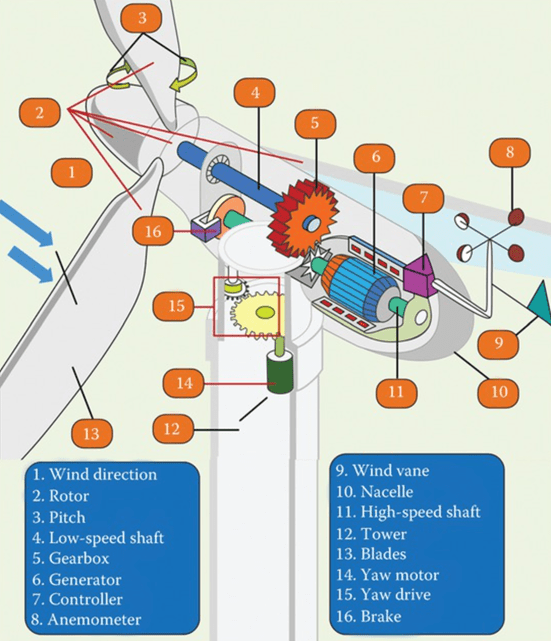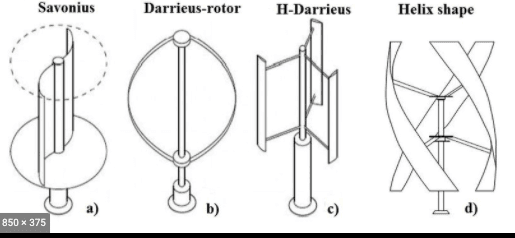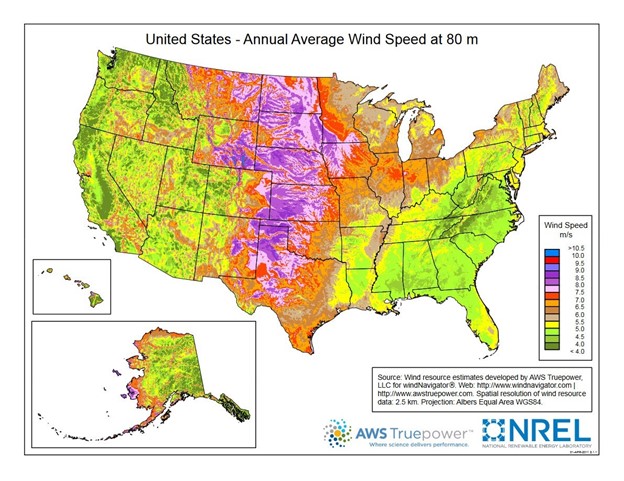Home Wind Turbines – Generate Your Own Clean Power
Wind is an important renewable energy resource that will help us get to net zero carbon emissions. Worldwide millions of kWh of clean wind energy are coming online each year. While most of this capacity is coming from utility scale wind farms, residential small wind energy systems in the form of home wind turbines have a role to play too. In this guide we’ll cover the following topics (feel free to skip to the one you need):
What is wind energy?
Why should I choose wind energy?
What are the basic parts of a small wind electric system?
How do wind turbines work?
Types of residential turbines?
What size wind turbine do I need?
Is there enough wind on my site?
What do wind systems cost?
Can I connect my wind turbine to my utility’s grid?
Can I go off-grid with a wind turbine?
What is wind energy?
Wind is caused by a bunch of air moving in the same direction. When the Earth rotates, solar rays heat some parts of its surface more than others creating areas of high pressure and low pressure. Wind is the effect of high pressure air rushing into a low pressure area. Wind power or wind energy is the process by which the wind is used to generate mechanical power that can generate electricity through the use of a wind turbine.
Why should I choose wind energy?
What are the advantages of wind power and why should you consider a home wind turbine? Obviously, wind is an excellent renewable energy source and can offer you a cost effective way to offset some or all of your electricity expenses by generating your own electricity. In addition, by installing a home wind turbine you are helping us all get to net zero carbon emissions by 2050. However, like solar, cost effective wind power is very much dependent on the characteristics of your property and the area you live.
Depending on the amount of electricity you wish to generate, a small wind electric system requires enough wind where you live and enough property to build the system. Different communities also have different zoning laws governing the use of wind turbines that you’ll need to examine closely before undertaking the project.
What are the basic parts of a small wind electric system?
The main parts of a home wind turbine typically consist of a rotor, a generator or alternator mounted on a frame, a tail, a tower, wiring, and other necessary parts that make up the wind turbine. Below is a diagram of a wind turbine with more detailed definitions of the various components.

- Rotor – The rotor is the rotating part of a turbine, typically with 2-3 blades. Rotor blades are usually hollow, made of composite material. The trend is to make blades larger, lighter and stronger to generate more power. Blades are aerodynamically wing-shaped and can rotate up to 90° about their axes (pitch) to maximize the amount of energy captured from the wind.
- Gearbox – The gearbox connects the low-speed shaft to the high-speed shaft in the generator.
- Generator – The generator is the mechanical energy-converting component of a wind turbine. This is the same structure as an electric motor.
- Controller – The controller connects to the anemometer and governs the speed of the generator so that if the wind is blowing too fast for the generator it won’t burn out the motor.
- Anemometer – An anemometer is an instrument that measures wind speed and wind pressure, by counting the number of rotations.
- Wind vane – Wind vanes are used to keep the wind turbine pointing into the wind.
- Nacelle – The nacelle is the casing that houses the controller gearbox, generator and shafts.
- Tower – A tower is the structure that supports the wind turbine. There are two generic tower types: freestanding and guyed. Guyed towers use supporting wires attached to secure the tower, while freestanding towers are self-supported. Guyed towers are most commonly used with home wind energy systems due to their lower cost and ease of installation compared to freestanding towers.
- Yaw Motor & Drive – The yaw motor and drive are used to orient the rotor so that it is facing the wind. As the wind changes direction the nacelle and rotor pivot around the axis of the tower.
- Brake – The brake of a wind turbine is used to stop the rotor from spinning during excessively windy conditions that could damage the turbine.
Wind is an important renewable energy resource that will help us get to net zero carbon emissions. Worldwide millions of kWh of clean wind energy are coming online each year.
How do home wind turbines work?
Wind turbines are installed on top of tall towers and are designed to harness the kinetic energy of the wind. When the wind blows the rotor blades will spin, turning the turbine shaft, which powers the generator. The generator creates direct current (DC) electricity that can either feed the grid or can be converted to alternating current (AC) to provide power to your home or business. As the wind changes direction the yaw motor and drive will position the rotor to face the wind to capture wind as it changes directions.
Types of home wind turbines?
Residential wind turbines typically generate between 20 watts to 100 kilowatts (kW) of energy. The lower end of the range is classified as micro wind turbines running from 20 to 500 watts while the upper end of the range 500 watts to 100 kilowatts are classified as small wind turbines. Small wind turbines are further classified into horizontal and vertical axis wind turbines. There are four primary types of vertical wind turbines pictured below.

The most commonly used small wind turbine is the horizontal-axis type. Horizontal wind turbines can have between 2-5 rotor blades.
The amount of power a wind turbine produces is determined by its swept area. A horizontal axis wind turbine’s swept area is measured by the area of the circle formed when the blades are spinning. A vertical axis wind turbine’s swept area is calculated by multiplying the rotor radius by the rotor height by 3.14. The larger the swept area the more power the wind turbine is capable of generating.
What size wind turbine do I need?
Before you research the size of wind turbine you need, it’s important to take the steps to reduce the amount of energy you are using in the first place. It’s often much more cost effective to reduce your energy usage through energy retrofits than to oversize your wind turbine.
Is the envelope of your home well sealed and insulated?
Are you using heat pump home heating and cooling systems?
Are you using a hybrid hot water heater?
By conducting a thorough home energy audit you can develop a better understanding of investments and paybacks you’ll receive from improving the energy efficiency of your home. You can then compare the energy efficiency investments with the costs and payback periods for energy generation projects like wind and solar.
From there, determining the size of wind turbine you need really depends on your energy budget. Your energy budget is how much energy you need to generate to offset your energy demands.
A typical home uses about 10,000 kilowatt-hours of electricity per year. That’s about 830 kWh per month on average. To offset this demand, a wind turbine would need to be rated around 5 to 15 kilowatts. A 1.5-kilowatt wind turbine can meet the needs of a home requiring 300 kWh per month in a location with an average annual wind speed of 14 miles per hour.
Is there enough wind on my site?
Determining if there is enough wind at your location is one of the most important questions you need to answer before undertaking the project. Even with the amount of data we have access to now, measuring or estimating the average wind speed at your site isn’t always easy.

The U.S. Wind Speed map produced by the National Renewable Energy Laboratory in conjunction with AWS Truepower shows the predicted average annual wind speed at a tower height of 80 meters (262 feet). Areas with annual wind speeds at or above 6.5 meters per second (14.5 miles per hour) are typically considered to have high enough wind speeds worth developing. The wind speeds on this map are based on modeled estimates that won’t represent the true wind speed of your site. There are state level wind maps, wind speed ratings from local airports and observing the effect of wind on vegetation in your area known as flagging that you can also use to get an understanding of the average wind speeds near your property. Also, don’t overlook the possibility of another operational wind turbine in your area that may prove an excellent source of data to help you better understand the average wind speed of your property.
However, these are only ways of estimating wind speeds. There are several factors that affect wind speed including the terrain of your property as well as any buildings or vegetation on your property. A more accurate but more time consuming way of estimating wind speed is to collect on-site measurements data from the location and height you’d like to locate your wind turbine. There are a number of affordable wind speed data collections products available on the market, but gathering a year’s worth of data is recommended which can really lengthen the timeline of your project.
What do wind systems cost?
The cost of a small wind turbine can vary by tens of thousands of dollars depending on the type of system you are building. These are the following variables that drive the cost to build and maintain a wind turbine:
- System Type (standalone, battery back, hybrid)
- Wind Turbine Size (wattage) & Type (horizontal or vertical)
- Tower Type and Height
- Off Grid or Grid Connected
Installing a small wind turbine is expensive. Installation costs vary depending on local zoning, permitting, and utility interconnection fees. For example, the average cost for small wind turbines installed in 2019 is $8,300/kilowatt.
Wind energy is a great option for those who want to switch to clean energy sources and have the property characteristics that will support a wind turbine. Although the initial investment is significant, it can be worth it in the long-term. The length of the “payback period” depends on a few factors: the system you choose, the wind resource on your site, electricity costs in your area, and how you use your wind system.
Can I connect my home wind turbine to my utility’s grid?
Yes, it’s technically possible to connect your residential wind turbine to the grid. A grid-connected home wind turbine can reduce your consumption of utility-supplied electricity, which will save you money on your electric bill. If the turbine is not producing enough energy for your needs, the utility will make up the difference and when the wind system produces more electricity than the household needs, the excess is sold to the utility. Connecting your wind turbine to the utility’s grid is called net metering or net billing. However, there are a lot of hoops to jump through and it’s really only practical if you meet the following criteria:
- Your site has average annual wind speed (at least 10 mph or 4.5 m/s).
- Your utility supplied electricity is expensive (greater than 10 cents per kWh)
- Your utility’s requirements for connecting their grid is reasonable
- There are good incentives for selling your excess clean energy
While the Public Utility Regulatory Policies Act of 1978 (PURPA) requires utilities to connect with small wind energy systems there is significant legal and safety work needed that will add time and expense to the project. Since you will need to get insurance and sign an interconnection agreement with the utility it is important that you protect yourself and get proper legal advice before entering into any agreement.
Can I go off-grid with a home wind turbine?
A hybrid small wind energy system matched with solar and battery backup can provide reliable power for you to go off-grid. A hybrid system that combines wind and solar offers several advantages. In much of the United States, the wind typically dies down in the summertime, making it harder to produce wind energy efficiently. In contrast, the wind is strong in the winter and at night when less sunlight is available. By combining these two types of energy, we can make up for the other’s shortcomings and create a steady and reliable output. When the wind isn’t blowing and the sun isn’t shining, most hybrid systems provide power from a battery-backup. Make sure that the battery can carry enough power to meet your electrical needs when it’s not charging. Battery banks generally range from 1-3 days worth of power.
An off-grid home wind turbine running on an hybrid system can work well if:
- Your property has an average annual wind speed of at least 9 miles per hour
- A grid connection is not available or too expensive
- You want to generate clean power, helping us get to net zero emissions by 2050
- You want energy independence
Contractors for Home Wind Turbines
Finding the right contractor can be the key to having a home wind turbine installed correctly and safely, and is certainly easier than doing it yourself. Beyond word-of-mouth recommendations, local building inspectors or trade groups may have a list of licensed contractors in your area.

